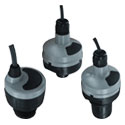Series ULS's Ultrasonic Level Sensor Applications
Series ULS's Ultrasonic Level Sensor Applications
With all the application options available it can be hard to imagine the Dwyer product line getting any better. However, we have recently introduced three Ultrasonic Level Sensors, the Model ULSL, ULSM and ULSS, that are so advanced in their function and application potential that they almost seem like they are straight out of a science fiction novel. These devices have the ability to determine the level of most liquids through non-contact technology and can transmit the given data, have four SPST programmable relays that are set up through a USB connection, and software. New software might seem like a scary concept for some individuals, and when everyone wants something that is easy to use with as minimal hassle as possible, price is a concern as well. These Ultrasonic Level Sensors have easy-to-use free software. In addition, the units use special internal mapping software that allows the ultrasonic to maintain a three inch sensing diameter. You might be thinking, What is the difference between the three new releases? The answer is simple. The three units are designed to handle different ranges of fluid, specifically 4.1’ (1.25 m), 9.8’ (3 m) and 18’ (5.5 m) respectively.

Dwyer lists these products as being used in dirty, corrosive, or sticky fluids, as well as with sump and small tank applications. In wastewater there are many processes needed to take the water we use and turn it back into clean water before using again. During primary and secondary wastewater treatment, a product called a clarifier is used. A clarifier is basically a very large tank; this could also be called a settling tank. The primary clarifier is used to remove large solids. As the fluid sits in the tank these solids separate out from the fluid allowing cleaner water to be pumped out. Later on in the process, a second clarifier is used for almost the same purpose. In this application it is essential to know that the exact fluid level in these tanks to maintain a uniform draw between the clarifier process and another equally important process of aeration. If the fluid draw between the two processes is not uniform, it causes dirty water to overflow. This can result in expensive fines. The precise nature and non-contact ability of the ultrasonic make this a primary target market.
These units are also used in the HVAC industry, specifically large server data centers. These large server farms are highly inefficient. They must maintain a constant temperature, and any temperature variation can cause the servers to go down which can result in unnecessary costs. Chilled water is utilized in order to cool the systems. Without accurate measurement, the temperature can rise at a rate that can’t be controlled by installed fail-safe devices. In this application, the water level in the cooling tower is monitored.
The addition of Models ULSL, ULSM and ULSS increase the amount of application options available to Dwyer as well as adding new technology to increase our ability to better serve our customers.
